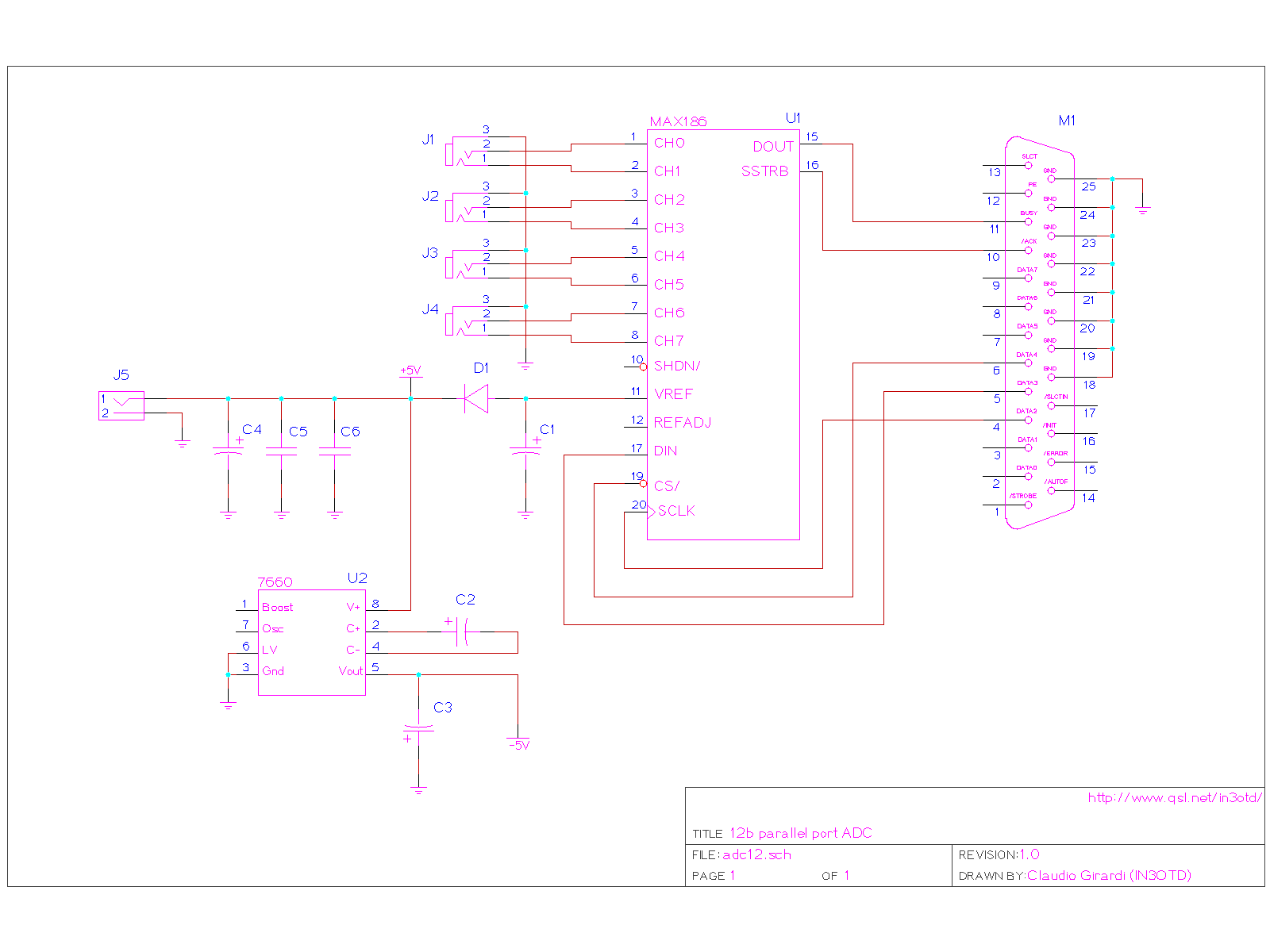
Homebrewing

This simple PC parallel port ADC features 12-bit resolution and four differential input channels. The chip, MAX186, can achieve speeds up to 133 k samples per second, although the actual performance will depend on the software utilized. A basic C program was developed to test the ADC on a Linux system, allowing for the acquisition of a selectable number of samples (with a default of 1000 samples for each channel). The program also computes the acquisition time, mean values, and variances for the readings from the four channels. When tested on a PC equipped with a 333 MHz AMD K7 processor, this circuit demonstrated a throughput of approximately 2.5 k samples per second.
The circuit utilizes the MAX186 analog-to-digital converter (ADC), which is designed for high-speed data acquisition applications. With its 12-bit resolution, the MAX186 can convert analog signals into digital values, providing a detailed representation of the input signal. The four differential input channels allow for the measurement of signals with respect to a common reference, which is particularly beneficial in noisy environments where common-mode rejection is essential.
The interface to the PC is established via the parallel port, which allows for direct communication between the ADC and the computer. This connection is crucial for transferring the digital data generated by the ADC to the processing software. The performance of the ADC is influenced by the software's ability to manage data acquisition and processing efficiently. The C program written for this application serves as a basic framework for interacting with the ADC, enabling users to specify the number of samples to be taken from each channel.
The program's functionality includes calculating the acquisition time, which is vital for understanding the speed of data collection. Additionally, it computes the mean and variance of the sampled data, providing insights into the stability and reliability of the measurements. The testing on a system with a 333 MHz AMD K7 processor yielded a throughput of 2.5 k samples per second, which illustrates the practical limitations of the setup in terms of speed, despite the theoretical capabilities of the MAX186.
This ADC circuit can be applied in various fields, including data logging, sensor interfacing, and real-time signal processing, where accurate analog measurements are required. Further optimization of the software and hardware components could potentially enhance the throughput and overall performance of the system.This simple PC parallel port ADC has 12 b resolution, four differential input channels and is it`s quite fast; the chip itself ( MAX186 ) is able to go up to 133 ksamples/s, but the actual speed will be determined by the software used. I wrote a simple C program to test the ADC with Linux; it acquires a selectable number of samples (default 1000 s
amples for every channel) and computes the acquisition time and the mean values and variances for the four channel readings. Tested on a PC with a 333 MHz AMD K7 processor this circuit had a throughput of about 2. 5 ksamples/s 🔗 External reference
The circuit utilizes the MAX186 analog-to-digital converter (ADC), which is designed for high-speed data acquisition applications. With its 12-bit resolution, the MAX186 can convert analog signals into digital values, providing a detailed representation of the input signal. The four differential input channels allow for the measurement of signals with respect to a common reference, which is particularly beneficial in noisy environments where common-mode rejection is essential.
The interface to the PC is established via the parallel port, which allows for direct communication between the ADC and the computer. This connection is crucial for transferring the digital data generated by the ADC to the processing software. The performance of the ADC is influenced by the software's ability to manage data acquisition and processing efficiently. The C program written for this application serves as a basic framework for interacting with the ADC, enabling users to specify the number of samples to be taken from each channel.
The program's functionality includes calculating the acquisition time, which is vital for understanding the speed of data collection. Additionally, it computes the mean and variance of the sampled data, providing insights into the stability and reliability of the measurements. The testing on a system with a 333 MHz AMD K7 processor yielded a throughput of 2.5 k samples per second, which illustrates the practical limitations of the setup in terms of speed, despite the theoretical capabilities of the MAX186.
This ADC circuit can be applied in various fields, including data logging, sensor interfacing, and real-time signal processing, where accurate analog measurements are required. Further optimization of the software and hardware components could potentially enhance the throughput and overall performance of the system.This simple PC parallel port ADC has 12 b resolution, four differential input channels and is it`s quite fast; the chip itself ( MAX186 ) is able to go up to 133 ksamples/s, but the actual speed will be determined by the software used. I wrote a simple C program to test the ADC with Linux; it acquires a selectable number of samples (default 1000 s
amples for every channel) and computes the acquisition time and the mean values and variances for the four channel readings. Tested on a PC with a 333 MHz AMD K7 processor this circuit had a throughput of about 2. 5 ksamples/s 🔗 External reference